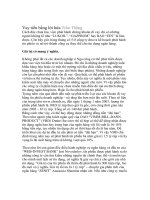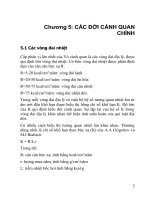Tài liệu Các mã báo lỗi PC doc
Bạn đang xem bản rút gọn của tài liệu. Xem và tải ngay bản đầy đủ của tài liệu tại đây (183.33 KB, 28 trang )
Computer main board defect post card
CODE Award AMI Phoenix4.0/Tandy3000
CODE Award AMI Phoenix4.0/Tandy3000
00 Code copying to
specific areas is done.
Passing control to INT
19h boot loader next.
01 Processor Test 1, Processor
status (1FLAGS) verification.
Test the following processor
status flags: carry, zero, sign,
overflow.
CPU is testing the
register inside or failed,
please change the CPU
and check it.
The BIOS sets each flag,
verifies they are set, then turns
each flag off and verifies it is
off.
02 Test All CPU Registers Except
SS, SP, and BP with Data FF
and 00
Verify Real Mode
03 Disable NMI, PIE, AIE, UEI,
SQWV.
The NMI is disabled.
Next, checking for a
soft reset or a power
on condition
Disable Not masked
Interrupt (NMI)
Disable video, parity checking,
DMA.
Reset math coprocessor.
Clear all page registers, CMOS
shutdown byte.
Initialize timer 0, 1, and2,
including set EISA timer to a
known state.
Initialize DMA controllers 0
and 1.
Initialize interrupt controllers
0 and 1.
Initialize EISA extended
registers.
04 RAM must be periodically
refreshed to keep the memory
from decaying. This refresh
function is working properly.
Get CPU type
05 Keyboard Controller
Initialization
The BIOS stack has
been built. Next,
disabling cache
memory.
DMA initialization in
progress or failure
CODE Award AMI Phoenix4.0/Tandy3000
06 Reserved Uncompressing the
POST code next.
Initialize system
hardware
07 Verifies CMOS is Working
Correctly, Detects Bad Battery
Next, initializing the
CPU and the CPU
data area
Disable shadow and
execute code from the
ROM.
08 Early chip set initialization The CMOS checksum
calculation is
Initialize chipset with
initial POST values
Memory presence test
OEM chip set routines
Clear low 64K memory
Test first 64K memory
09 Cyrix CPU initialization
Cache initialization
0A Initialize first 120 interrupt
vectors with SPURIOUS-INT-
HDLR and initialize INT 00h-
1Fh according to INT-TBL.
The CMOS checksum
calculation is done.
Initializing the CMOS
status register for date
and time next.
Initialize CPU registers
0B Test CMOS RAM Checksum,
if Bad, or INS Key Pressed,
Load Defaults
The CMOS status
register is initialized.
Next, performing any
required initialization
before the keyboard
BAT command is
issued
Enable CPU cache
0C Detect Type of Keyboard
Controller and
The keyboard
controller input buffer
is free. Next, issuing
the BAT command to
the keyboard
Initialize caches to
initial POST values
Set NUM_LOCK Status
0D Detect CPU Clock;
Read CMOS location 14h to
find out type of video in use.
Detect and initialize video
adapter.
CODE Award AMI Phoenix4.0/Tandy3000
0E Test Video Memory, write sign-
on message to screen.
Setup shadow RAM ?Enable
shadow according to setup.
0F Test DMA Cont. 0; BIOS
Checksum Test.
The initialization after
the keyboard
controller BAT
command test is done.
The keyboard
Initialize the local bus
IDE
Keyboard Detect and
Initialization.
10 Test DMA Controller 1 The keyboard
controller command
byte is written. Next,
issuing the Pin 23 and
24 blocking and
unblocking command
Initialize Power
Management
11 Test DMA Page Registers Next, checking if
<End> or <Ins> keys
were pressed during
power on. Initializing
CMOS RAM if the
Initialize CMOS RAM
in every boot
AMIBIOS POST
option was set in
AMIBCP or the
<End> key was
pressed.
Load alternate registers
with initial POST values
12 Reserved Next, disabling DMA
controllers 1 and 2
and interrupt
controllers 1 and 2
Restore CPU control
word during warm boot
13 Reserved The video display has
been disabled. Port B
has been initialized.
Next, initializing the
chipset
Initialize PCI Bus
Mastering devices
CODE Award AMI Phoenix4.0/Tandy3000
14 Test 8254 Timer 0 Counter 2 The 8254 timer test
will begin next.
Initialize keyboard
controller
15 Verify 8259 Channel 1
Interrupts by Turning Off and
On the Interrupt Lines
16 Verify 8259 Channel 2
Interrupts by Turning Off and
On the Interrupt Lines
BIOS ROM checksum
17 Turn Off Interrupts Then
Verify No Interrupt Mask
Register is On
Initialize cache before
memory Auto size
18 Force an Interrupt and Verify
the Interrupt Occurred
8254 timer initialization
19 Test Stuck NMI Bits; Verify
NMI Can Be Cleared
The 8254 timer test is
over. Starting the
memory refresh test
next
1A Display CPU clock The memory refresh
line is toggling.
Checking the 15
second on/off time
next
8237 DMA controller
initialization
1B reserved
1C Reserved Reset Programmable
Interrupt Controller
1D Reserved
1E Reserved
1F If EISA non-volatile memory
checksum is good, execute
EISA initialization.
If not, execute ISA tests an
clear.
EISA mode flag.
Test EISA configuration
memory
Integrity (checksum &
communication interface).
20 Initialize Slot 0 (System Board) Test DRAM refresh
21 Initialize Slot 1
22 Initialize Slot 2 Test 8742 Keyboard
Controller
CODE Award AMI Phoenix4.0/Tandy3000
23 Initialize Slot 3 Reading the 8042
input port and
disabling the
MEGAKEY Green
PC feature next.
Making the BIOS
code segment
rewritable and
performing any
necessary
configuration before
initializing the
interrupt vectors
24 Initialize Slot 4 The configuration
required before
interrupt vector
initialization has
completed. Interrupt
vector initialization is
about to begin
Set ES segment register
to 4 GB
25 Initialize Slot 5 Interrupt vector
initialization is done.
Clearing the password
if the POST DIAG
switch is on.
26 Initialize Slot 6
27 Initialize Slot 7 Any initialization
before setting video
mode will be done
next
28 Initialize Slot 8 Initialization before
setting the video mode
Auto size DRAM
is complete.
Configuring the
monochrome mode
and color mode
settings next
29 Initialize Slot 9 Initialize POST Memory
Manager
2A Initialize Slot 10 Initializing the
different bus system,
static, and output
devices, if present
Clear 512 KB base
RAM
CODE Award AMI Phoenix4.0/Tandy3000
2B Initialize Slot 11 Passing control to the
video ROM to
perform any required
configuration before
the video ROM test.
2C Initialize Slot 12 All necessary
processing before
passing control to the
video ROM is done.
Looking for the video
ROM next and
passing control to it.
RAM failure on address
line XXXX*
2D Initialize Slot 13 The video ROM has
returned control to
BIOS POST.
Performing any
required processing
after the video ROM
had control
2E Initialize Slot 14 Completed post-video
ROM test processing.
If the EGA/VGA
controller is not
found, performing the
display memory
read/write test next
RAM failure on data
bits XXXX* of low byte
of memory bus
2F Initialize Slot 15 The EGA/VGA
controller was not
found. The display
Enable cache before
system BIOS shadow
memory read/write
test is about to begin
30 Size Base Memory From 256K
to 640K and Extended Memory
Above 1MB
The display memory
read/write test passed.
Look for retrace
checking next
31 Test Base Memory From 256K
to 640K and Extended Memory
Above 1MB
The display memory
read/write test or
retrace checking
failed. Performing the
alternate display
memory read/write
test next
CODE Award AMI Phoenix4.0/Tandy3000
32 If EISA Mode, Test EISA
Memory Found in Slots
Initialization
The alternate display
memory read/write
test passed. Looking
for alternate display
retrace checking next.
Test CPU bus-clock
frequency
33 Reserved Initialize Phoenix
Dispatch manager
34 Reserved Video display
checking is over.
Setting the display
mode next.
35 Reserved
36 Reserved Warm start and shut
down
37 Reserved The display mode is
set. Displaying the
power on message
next
38 Reserved Initializing the bus
input, IPL, general
devices next, if present
Shadow system BIOS
ROM
39 Reserved Displaying bus
initialization error
messages.
3A Reserved The new cursor
position has been read
and saved. Displaying
the Hit <DEL>
Auto size cache
message next
3B Reserved The Hit <DEL>
message is displayed.
The protected mode
memory test is about
to start.
3C Setup Enabled Advanced configuration
of chipset registers
3D Detect if Mouse is Present,
Initialize Mouse, Install
Interrupt Vectors
Load alternate registers
with CMOS values
3E Initialize Cache Controller
3F Reserved
40 Display Virus Protest Disable
or Enable
Preparing the
descriptor tables next
41 Initialize Floppy Disk Drive
Controller and Any Drives
Initialize extended
memory for Rom Pilot
CODE Award AMI Phoenix4.0/Tandy3000
42 Initialize Hard Drive
Controller and Any Drives
The descriptor tables
are prepared.
Entering protected
mode for the memory
test next
Initialize interrupt
vectors
43 Detect and Initialize Serial &
Parallel Ports and Game Port
Entered protected
mode. Enabling
interrupts for
diagnostics mode next.
44 Reserved Interrupts enabled if
the diagnostics switch
is on. Initializing data
to check memory
wraparound at 0:0
next.
45 Detect and Initialize Math
Coprocessor
Data initialized.
Checking for memory
wraparound at 0:0
and finding the total
system memory size
next
POST device
initialization
46 Reserved The memory
wraparound test is
done. Memory size
calculation has been
Check ROM copyright
notice
done. Writing
patterns to test
memory next
47 Reserved The memory pattern
has been written to
extended memory.
Writing patterns to
the base 640 KB
memory next.
Initialize I20 support
48 Reserved Patterns written in
base memory.
Determining the
amount of memory
below 1 MB next.
Check video
configuration against
CMOS
49 Reserved The amount of
memory below 1 MB
has been found and
verified. Determining
the amount of
memory above 1 MB
memory next.
Initialize PCI bus and
devices
CODE Award AMI Phoenix4.0/Tandy3000
4A Reserved Initialize all video
adapters in system
4B Reserved The amount of
memory above 1 MB
has been found and
verified. Checking for
a soft reset and
clearing the memory
below 1 MB for the
soft reset next. If this
is a power on
situation, going to
checkpoint 4Eh next.
Quiet Boot start
(optional)
4C Reserved The memory below 1
MB has been cleared
via a soft reset.
Clearing the memory
above 1 MB next.
Shadow video BIOS
ROM
4D Reserved The memory above 1
MB has been cleared
via a soft reset. Saving
the memory size next.
Going to checkpoint
52h next
4E Reboot if Manufacturing Mode;
If not, Display Messages and
Enter Setup
The memory test
started, but not as the
result of a soft reset.
Displaying the first 64
KB memory size next.
Display BIOS copyright
notice
4F Ask Password Security
(Optional)
The memory size
display has started.
The display is updated
during the memory
test. Performing the
sequential and
random memory test
next
Initialize Multi Boot
50 Write All CMOS Values Back to
RAM and Clear
The memory below 1
MB has been tested
and initialized.
Adjusting the
displayed memory size
for relocation and
shadowing next.
Display CPU type and
speed
CODE Award AMI Phoenix4.0/Tandy3000
51 Enable Parity Checker. Enable
NMI, Enable Cache Before Boot
The memory size
display was adjusted
for relocation and
shadowing. Testing
the memory above 1
MB next.
Initialize EISA board
52 Initialize Option ROMs from
C8000h to EFFFFh or if
FSCAN Enabled to F7FFFh
The memory above 1
MB has been tested
and initialized. Saving
the memory size
information next.
Test keyboard
53 Initialize Time Value in 40h:
BIOS Area
The memory size
information and the
CPU registers are
saved. Entering real
mode next.
54 Shutdown was
successful. The CPU is
in real mode.
Set key click if enabled
Disabling the Gate
A20 line, parity, and
the NMI next
55 Enable USB devices
57 The A20 address line,
parity, and the NMI
are disabled.
Adjusting the memory
size depending on
relocation and
shadowing next.
58 The memory size was
adjusted for relocation
and shadowing.
Clearing the Hit
<DEL> message next
Test for unexpected
interrupts
59 The Hit <DEL>
message is cleared.
The <WAIT...>
message is displayed.
Starting the DMA and
interrupt controller
test next.
Initialize POST display
service
5A Display prompt 'Press
F2 to enter SETUP'
CODE Award AMI Phoenix4.0/Tandy3000
5B Disable CPU cache
5C Test RAM between 512
and 640 KB
60 Setup virus protection (boot
sector protection) functionality
according to setup setting.
The DMA page
register test passed.
Performing the DMA
Controller 1 base
register test next.
Test extended memory
Try to turn on level 2 cache (if
L2 cache already turned on in
post 3D, this part will be
skipped)
Set the boot up speed according
to setup setting
Last chance for chipset
initialization









